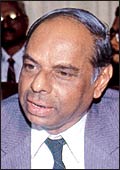|
 When
the sensex kissed the 10,000 mark for the first time ever on the
Bombay Stock Exchange (BSE) last fortnight, it was yet another
sign that India as a market for global liquidity had arrived.
That the benchmark index dipped below 10k by closing isn't important
(and whether it falls further or goes on to newer highs by the
time you read this isn't the point, either). What's significant
is that a major psychological barrier-and that may be all it is-had
been breached. After all, with the Sensex entering five-digit
territory, it's now rubbing shoulders with the 110-year-old Dow
Jones Industrial Average Index (DJIA)-which was at 10,793.62 on
February 3, 2006 at the time of writing. Says Jaideep Goswami,
Head of Institutional Equities, HDFC Securities: "It reflects
that there is a huge level of interest in our markets and that
sentiments are still very strong. (On the day the Sensex hit 10k),
the Japanese were strong buyers, which certainly augurs well." When
the sensex kissed the 10,000 mark for the first time ever on the
Bombay Stock Exchange (BSE) last fortnight, it was yet another
sign that India as a market for global liquidity had arrived.
That the benchmark index dipped below 10k by closing isn't important
(and whether it falls further or goes on to newer highs by the
time you read this isn't the point, either). What's significant
is that a major psychological barrier-and that may be all it is-had
been breached. After all, with the Sensex entering five-digit
territory, it's now rubbing shoulders with the 110-year-old Dow
Jones Industrial Average Index (DJIA)-which was at 10,793.62 on
February 3, 2006 at the time of writing. Says Jaideep Goswami,
Head of Institutional Equities, HDFC Securities: "It reflects
that there is a huge level of interest in our markets and that
sentiments are still very strong. (On the day the Sensex hit 10k),
the Japanese were strong buyers, which certainly augurs well."
However, the narrowing of the gap between
the Sensex and DJIA shouldn't by any yardstick be taken as a sign
that the Indian markets are in the same league as their American
and Japanese counterparts. For one, DJIA had a market cap of $3,770
billion (Rs 1,69,65,000 crore) as of late last year. The Sensex's
market cap, on the other hand, at the near-10,000 levels is just
$582 billion (Rs 26,19,000 crore). As Andrew Holland, Executive
Vice President, DSP Merrill Lynch, points out: "It wouldn't
be fair comparing the Sensex to the Dow or the Nikkei, as the
depth and breadth of those markets are much superior."
What's more, if India's markets have entered the 10k zone, it
isn't the only one in the emerging market space. Turkey, for instance,
is over four times that level, in the 45,000 range, Poland's benchmark
index is close to 40k, Egypt is on fire, hovering near the 65k
mark, and Brazil is in the 37,000-38,000 range. Even Pakistan
has crossed the 10k mark (before India, we dare say). As per data
from The Economist, there are at least 12 other emerging markets
that have crossed the 10k mark, many of them comfortably, and
a long time ago.
But it's when you start co-relating the gross
domestic product (GDP) growth of emerging markets with their respective
indices-markets are supposed to reflect the health of the economy,
right?-that India emerges as a key player. With a stock market
that's perched at 10k and a GDP growth that stood at 8 per cent
for the third quarter, India is arguably the best placed amongst
the entire emerging market lot. China's GDP did grow at 9.9 per
cent for the fourth quarter, but its stock markets languish in
the 1,300 range. Then you have a country like Brazil, where the
benchmark index is in 37,000 territory, but its GDP grew at just
1 per cent in the third quarter. In a similar vein you have Mexico
with an index in the 18k range, but with GDP growth of just 3.3
per cent (for the third quarter).
The upshot? At the end of the day, index
records in isolation are a great boost for sentiment, but fundamentally
they may account for little, if not backed by solid economic (and
corporate) performance. As Tridib Pathak, CIO, Cholamandalam AMC,
points out: "I don't think we should give too much importance
to the fact that the Sensex has hit 10,000. It is just a figure
and has no consequential meaning. I would look for two things:
market valuation and visibility of growth. If the valuations,
for instance, reach historic highs, then there would be reason
for euphoria." From the investors' point of view, Pathak
adds, more than 10k, what should matter are figures for earnings
growth, price-earning multiples and, of course, the performance
of the economy.
-Krishna Gopalan and Mahesh Nayak
INSTAN
TIP
The fortnight's burning question.
Q. Will Budget 2006 Spur Growth?
Yes. R. Gopalakrishnan,
Executive Director, Tata Sons
We are on a good phase of economic growth.
There are many constraints. And I think the atmosphere is built
up to de-bottleneck those constraints and push the levers of growth.
I don't see too many economic bubbles. But I am concerned whether
India Inc. is prepared for a downturn. We are in a phase where
we could expect a slowdown after a good four-year run. However,
I don't see a disaster.
Yes and No. Subir
Gokarn, Chief Economist, CRISIL
I don't expect the budget to act as a hindrance
to India's growth. However, there are many issues like spend on
infrastructure. It's not important as to how much money is allocated
towards infrastructure development, but the critical issue is
how the government implements and delivers its spending on infrastructure
development.
Yes. Nilesh
Shah, President, Kotak AMC
I think incremental policy in the Budget
towards infrastructure development and manufacturing sector will
help in capacity expansion and, hence, certainly spur growth in
the economy.
--compiled by Mahesh Nayak
Just
What's So Hot About Ganesh Bank?
 |
| RBI's Reddy: Staying cool |
It's
not every day that any-forget a nondescript-bank screws up courage
enough to take on the mighty Reserve Bank of India. So, the puny
Ganesh Bank of Kurundwad's decision to successfully move the Supreme
Court to block its RBI-blessed merger with Federal Bank comes
as some surprise. But then perhaps not. The failed and loss-making
Ganesh Bank (Rs 217 crore in deposits and Rs 106 crore in advances)
has vastly bigger banks wooing it, including, reportedly, Citibank,
the largest cooperative bank Saraswat and, of course, Federal
Bank. What makes the 85-year-old Ganesh Bank hot property? For
Saraswat, it's an opportunity to eliminate a competitor in Maharashtra,
while for Citi and Federal Ganesh's network of 32 branches in
Maharashtra and Karnataka is an ideal vehicle to reach the masses.
How is the RBI taking the challenge to its authority? "The
judiciary has its own role in the system," is all that an
insider would say.
-Anand Adhikari
Not
just a fund, but Fund of funds
 |
| TWP's Srini: A first for India |
Yet
another fund announcing plans of investing in India doesn't turn
heads anymore. But when an investment banking firm says that it's
stitching together a fund of funds for India, you know the lure
is real. Thomas Weisel Partners (TWP), a US-based investment banking
firm, is close to finalising a $300-million (Rs 1,350-crore) fund
of funds for India. "We plan to distribute this amount between
private equity and venture capital companies focussed on four
high-growth sectors of technology, infrastructure, healthcare/life
sciences and retail," says Vudayagiri "Srini" Sreenivasulu,
37, Director for TWP India. Currently based in San Francisco,
Sreenivasulu, who previously was at Intel Capital in Bangalore,
will relocate to Mumbai.
-Rahul Sachitanand
A
Crude Mess
A sleight of hand won't help oilcos.
 |
| Rangarajan: Not an easy job to deliver |
The
high-powered C. Rangarajan committee, set up to evolve a fuel
pricing policy for petro-products, is likely to recommend a trade
parity pricing regime for the oil sector. That means prices of
fuels like petrol, diesel, LPG and kerosene would be determined
by a combination of export and import parity prices. Since it
boasts excess refining capacity, India imports crude and exports
some amount of petrol and diesel. These will now be retailed at
export prices. Other products, such as cooking gas, will be sold
at the imported price and not at the subsidised government-determined
price. Secondly, the committee is expected to reduce import duties
on crude to bring about some kind of parity between it and petroleum
products. After all, Budget 2005 had reduced customs duty on petrol
and diesel by 15 per cent to 10 per cent respectively, but that
on crude only by 5 per cent. Oil companies don't think a mere
tinkering with import tariffs is going to help their bleeding
bottom lines. Instead of wasting time on cosmetic changes, the
government should link prices of petrol and diesel either to international
prices or work out a cost-plus formula on a certain price band,
says an official at Indian Oil. As for the subsidy on kerosene
and LPG, the best way to deal with it, say others, is to shift
the burden from the oil companies to the Budget. With crude prices
unlikely to return to the $40 (Rs 1,800)-a-barrel level of yore,
it's clear that the government needs to take some tough decisions.
Losses at oil companies are soaring, and for the first three quarters
of 2005-06, they stand at Rs 25,000 crore.
-Ashish Gupta
Paper
Balm To The Pain
 |
| Oil woes: Will the flow stem? |
Oil
companies are bleeding and all that the government wants to do
is apply Band-Aid. It has offered to allow oil companies to issue
bonds worth Rs 5,763 crore with a coupon rate of 7 per cent, redeemable
in 2012. It's not the first set of oil bonds, but it's the first
one meant to bridge oil marketing companies' yawning losses; most
of them reported losses for the first time ever last year. But
how much will these bonds, which can be transferred in favour
of any other person including banks and corporations, help when
the total losses are at Rs 25,000 crore? Not much. "Oil bonds
will help companies overcome their liquidity crunch in the short
term, but they are not a long-term solution," notes Ravi
Mahajan, energy expert at Ernst & Young. There is only long-term
solution: Removing government controls on oil prices.
-Shaleen Agrawal
The
Numbers Don't Tell The Whole Story
India Inc. delivered as expected in
Q3. But oil and steel ruined the report card.
 |
| Q3 results: Here red isn't a good sign |
India
Inc. will be disappointed. a total of 1,984 companies recorded
a net profit of Rs 30,540 crore for the quarter ended December
31, 2005, compared to Rs 29,590 crore during the previous corresponding
period, an increase of a mere 3.2 per cent. The metals and oil
& gas sectors were mainly responsible for the poor show. The
net sales of the companies during the quarter under review jumped
15.3 per cent to Rs 3,87,674 crore from Rs 3,36,207 crore during
the previous corresponding quarter. The logical inference: margins
were under pressure.
However, if we consider the overall results
minus these two sectors, the picture changes quite dramatically.
A total of 1,901 companies recorded a 36 per cent growth in net
profit to Rs 24,716 crore (Rs 18,129 crore) on the back of an
18 per cent rise in net sales to Rs 2,33,848 crore (Rs 1,98,498
crore). This impressive report card is primarily due to the performance
of the software, banking, pharmaceuticals, automobiles, cement
and capital goods sectors. During the quarter under review, the
collective operating profit margins of these companies improved
by 191 basis points to 26.72 per cent from 24.82 per cent, despite
a 19.3 per cent rise in interest costs to Rs 29,721 crore.
Says Gagan Banga, Executive Director, Indiabulls
Financial Services: "India Inc. has delivered as per expectations
if you set aside the results of oil and steel companies. But the
non-performance of these two sectors is a cause for concern, as
they generate substantial employment. It can also have an impact
on the market, as companies from these sectors have a huge market
capitalisation and account for substantial weightage on major
indices."
The steel sector suffered because of the
slowdown in China and a flood of cheap imports. But there's a
silver lining, too. Says Banga: "Steel is a major input for
most companies. If prices remain subdued, the operating margins
of India Inc. will shoot up further." The oil sector suffered,
as it was not allowed to charge market prices for its products
and also made to share the government's subsidy burden. The sector
recorded a 51 per cent fall in net profit to Rs 4,261.5 crore
(Rs 8,746 crore) for the quarter ended December 31, 2005. Its
net sales, however, jumped 15.6 per cent to Rs 1,35,240 crore
(Rs 1,17,001 crore).
Overall, it's been a good show. However rising
interest rates could have an impact on margins in the coming quarters.
-Mahesh Nayak
Another
first for Dr Reddy's
 |
| DRL's Prasad: Tapping opportunities |
Dr Reddy's Laboratories
(DRL) has entered into an agreement with pharma major Merck &
Co. to sell and distribute generic versions of two of its patented
drugs, Zocor and Proscar, once they go off patent in the US in
June this year. It is the first Indian pharma company to enter
into such a deal with a multinational. "We will continue
to look at such opportunities going forward," says G.V. Prasad,
Executive Vice chairman and CEO, DRL. "The deal, per se,
is not innovative, as other companies have done it in the past,"
he adds. Prasad, however, is quick to emphasise that this does
not signal a shift in DRL's long-term strategy of becoming a discovery-led
global pharmaceutical company. "It's more in the nature of
a sensible opportunity that the company is tapping in the marketplace,"
he explains. The markets have welcomed the news. DRL's stock touched
a 52-week high of Rs 1,215 on February 2, 2006. It closed at Rs
1,190.40 on February 6.
-E. Kumar Sharma
KKR
Turns to Asia and India
 |
| KKR's Marks: Sold on Indian IT |
As the CEO of
Flextronics, Michael Marks in June 2004 led the purchase of Hughes
Software Systems from Rupert Murdoch's DirecTV. Now as a Member
of the legendary buyout firm, Kohlberg Kravis & Roberts, responsible
for advising on Asia and technology, Marks may be helping KKR,
a late entrant to the Asian market that he joined end last year,
strike its first Indian deal. When BT went to press, HSS' (now
called Flextronics Software Systems) President & Managing
Director, Arun Kumar, was in the US as part of the ongoing due
diligence exercise, and a Flextronics International spokesperson
said "we have no comment". But sources told BT that
the deal, which might see KKR buy a significant stake in FSS,
could be announced by February-end. Flextronics had bought HSS
for $226 million, or Rs 1,017 crore.
Filling
the Gap in India?
The government's
decision to allow 51 per cent FDI (foreign direct investment)
in single-brand retail outfits has got some of the biggest players
interested. Gap, the $16.3-billion (Rs 73,350-crore) apparel retailer
with brands like Banana Republic and Old Navy, besides the flagship
label, is making aggressive moves in Asia. It recently announced
its first franchise in South-East Asia with retailer FJ Benjamin,
which will sell the Gap and Banana Republic Brands in Singapore
and Malaysia. Although Pantaloon's Kishore Biyani denies it, he
is expected to land a multi-franchise agreement with Gap in India.
When contacted by BT, a Gap representative, Kris Marubio, said
that Gap "will consider a foray into India at the appropriate
time". Given that in the US, Gap is fighting sluggish sales,
it may not be too long before it builds a presence in virgin markets
like India. Currently, Gap's international operations fetch $1.5
billion (Rs 6,750 crore) a year.
-Rahul Sachitanand
Seeds
Of Discontent
Is Monsanto stiffing cotton farmers?
 |
| Bt cotton: Good, but pricey |
On January 23,
as the congress plenary session was winding up at Gachibowli in
Hyderabad, Andhra Pradesh Chief Minister Y.S. Rajasekhara Reddy
handed a letter to Prime Minister Manmohan Singh. It had nothing
to do with party politics. Instead, Reddy was trying to enlist
the pm in a fight against us-based Monsanto, which markets Bt
cotton seeds in India. Why? Reddy argues that Monsanto and its
Indian JV, Mahyco Monsanto Biotech don't have patent over Bt technology
in India, but have collected Rs 50 lakh from other Indian seed
companies to which they sell Bt cotton seeds. That apart, Monsanto
and Mahyco are said to be charging a high "trait value"
(sort of a royalty), which, in the case of a 450-gm seed packet,
works out to Rs 1,250 of the retail price of Rs 1,850. The trait
value, the argument continues, is not just 12 times the cost of
seed production, but higher than those prevailing in the us (Rs
108) and China (Rs 34). Says Poonam Malakondaiah, Commissioner
and Director of Agriculture, AP: "We have nothing against
the company and the technology, but we have been getting large
representations from the farmers (about the) exorbitant price."
About 80 per cent of the farmers in the state have small holdings
and, therefore, find the seed price too high. Pricing, Mahyco
counters, is based on the value that products and technology deliver
to farmers. And technology fees help fund research, and are shared
with the retail technology channel, seed partners, shareholders
and to cover business costs. No doubt Bt seeds have revolutioned
cotton farming in AP, but Monsanto finds itself in a drug innovator
company-like situation. Except in this case, farmers are a far
more powerful vote bank than mere pill-poppers.
-E. Kumar Sharma
|




 W
W







